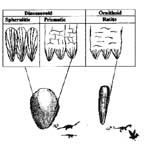Two major types of dinosaur eggs are recognized: spheroidal and elongated. These types can be further sub-divided based on length/diameter ratios, the thickness of the shell, the type of pores and the surface of the egg (may be ornamented).

The egg structure consists of a series of basic vertical units that grow from particular sites on the surface of the shell.
The organization of these units determines the classification scheme, being either spherulitic or prismatic:
1. Spherulitic egg shells show spherical patterns in the crystalline structure, and they are seen in sauropods and hadrosaurs.
2. Prismatic egg shells grow into spherical crystals only in the lower portion of the shell, while crystals in the upper portion are prisms.
3. Ornithoid eggs (also seen in birds) are generally laid by theropods. In this type only the very bottom part of the shell exists as separate or discrete units (mammilae). The upper and mid-portions of the shell consist of a mass of biocrystalline material with a spongy (squamatic) ultrastructure that comprises a homogeneous layer.
How a sauropod from an 18 cm diameter egg could grow to a 30 metre long animal weighing about 20 tones? There are two possible answers:1. The animal grows throughout its lifecycle, perhaps continuing to grow until death. Many reptiles do a similar thing.
2. The animal undergoes accelerated growth in 5-15 years. Growth patterns from dinosaur bone such as the 'duck-billed' dinosaur Maiasaura indicate it reached adult size in 5 years. Elephants take about 15 years to reach sexual maturity. Maybe sauropods lied in between.
Other dinosaur eggs are often smaller. The smallest eggs are perhaps from the prosauropods. Eggs from South Africa are reported to be only 6.5 cm long and 5.5 cm wide. The shell is only 0.2/0.3 mm (0.02 cm!) thick. Theropod eggs are generally 10-15 cm long, and a couple of millimeters thick. Duckbills (hadrosaurs) also have eggs 10-12 cm long and 7.9 cm wide